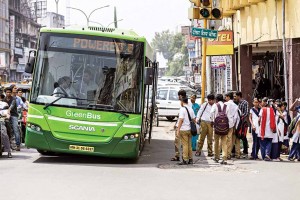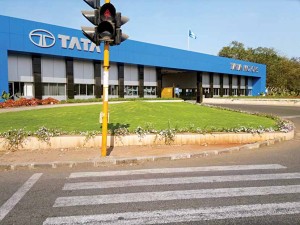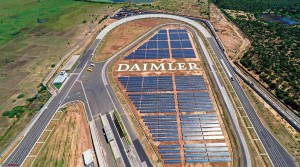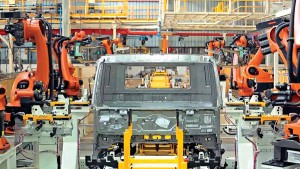Successful operation of ethanol, hybrid and electric buses in India is reflective of the fact that the CV industry is set to take the lead in clean tech.
Story by:
Bhushan Mhapralkar
Commercial vehicles mean business, and are part of the auto sector that contributes four per cent to India’s GDP. Over 90 per cent of CVs in India are diesel powered, and the remaining 10 per cent are CNG powered. CNG has been limited to selective urban areas of the country due to infrastructural limitations. An indication of the fact that the CV industry has always been active and at the forefront of clean tech, the best example would be the quick transformation of the complete fleet of DTC city buses in 1998 to CNG as part of the apex court’s order, which would mark the first phase of environmental reforms in the country. Many city bus corporations followed DTC and either converted or procured CNG buses. CV manufacturers and engine builders like Cummins were quick to respond with CNG engines and vehicles. That was the time when BS I and BS II found a way into India. The quest for BS VI (equivalent of Euro 6 emission regulations) by 2020 is set to present the CV industry an ability to lead in clean tech. The industry has in fact already snatched the lead by moving more people per vehicle by introducing ethanol, electric and hybrid buses in India.
The Scania ethanol powered city bus was pressed into the city bus service at Nagpur two years ago, and has been successfully operating since then. It uses 95 per cent ethanol, and is supported by a local infrastructure including the production of an additive termed as the ‘ignitor’. An order for the supply of 55 more such buses is claimed to be underway by Scania sources. The sources also claim that the ethanol bus at Nagpur is capable of meeting BS V emission norms from day one of its operation. Scania’s experience in ethanol buses dates back to 1980 when it first introduced an ethanol powered bus in Europe.
Reflecting on Volvo’s long standing experience in hybrid and electrically propelled commercial vehicles, the Volvo 8400 hybrid city bus at Navi Mumbai was introduced early this year. The State of Maharashtra is known to have entered into a purchase agreement for five such locally assembled buses, giving the CV industry a definitive lead in environmental technology. The 8400 low-floor hybrid bus employs a 5.0-litre, 4-cylinder (Euro 4 compliant) diesel engine that is coupled with a powerful electric motor. They cumulatively produce 160hp, and by consuming far less fuel than an equivalent diesel engine powered bus would. The bus also emits less since it uses electric power for most supplementary functions including air conditioning, automatic bus doors, and takes off in electric mode. The diesel engine couples itself only after the bus has gained a speed of 15 kmph, making it an environmentally friendly offering considering its start-stop nature of operation.
Late last year, Prime Minister Narendra Modi flagged off a smart electric bus, developed indigenously by Pune-based IT engineering major KPIT in partnership with the Central Institute of Road Transport (CIRT). The project was initiated by India’s Minister of Road Transport and Highways (MoRTH) Nitin Gadkari, and resulted in a bus that would ferry the members of Parliament. A reflection of electric bus technology being safe, reliable, and well suited for Indian road conditions, the initiative, which involved the conversion of a conventional diesel powered bus into an electric one, has earned KPIT 20+ global patents. The two retrofitted buses leverage Li-Ion batteries and multiple AC induction motors. The controller can bring in one or more motors online, depending on the power and torque requirements. The buses have a range of 100 to 200 km (depending on the configuration of Li-ion battery packs). The motors can generate power between 80 and 240 kW with a Torque in the range of 450 and 600 Nm (depending on the selected configuration). With technology specifically adapted to Indian conditions, the KPIT electric buses also integrate intelligent transportation system and provide real-time monitoring including the location of the bus, their health and driver behaviour apart from traffic data and performance.
Tata Motors is set to supply 25 hybrid city buses to MMRDA for their Bandra-Kurla Complex. To ply between the Bandra-Kurla Complex and nearby railway stations of Kurla, Bandra and Sion, the buses, once deployed will further endorse the CV industry’s lead in clean tech.
Clean tech lead in manufacture
Tata Motors currently sources around 8 per cent of its electricity from renewables. It has solar energy installations at three plants, of which two plants are at Pune and Dharwad respectively, and manufacture commercial vehicles. Having joined the RE100 initiative of The Climate Group, Tata Motors is switching all its manufacturing operations to 100 per cent renewable energy. Special efforts are being undertaken to conserve energy. These include waste heat recovery system to recover waste heat from exhaust flue gases of surfacer and finish paint baking ovens, conversion of indirect fired baking ovens into direct fired burner of baking ovens, conversion of electrical heating into natural gas heating system for washing machines, use of energy efficient LED lighting, compressed air pressure optimisation at paint shop and at other shops, use of portable small compressors for low compressed air requirement on holidays, and more. The various efforts to conserve energy are claimed to have resulted in cost savings for the company of around Rs. 14.5 crore and annual CO2 emission reduction of 13,960 tCO2e.
Mahindra, at its modern Chakan plant where the heavy and medium duty trucks are built among a host of other automobiles, has a cluster of 70 solar dishes that generate power. Waste water is recycled through reverse osmosis and multiple effect evaporation. This helps achieve zero water discharge. Ashok Leyland’s manufacturing units at Bhandara and Hosur have won many environment management and conservation awards instituted by external agencies including the Golden Peacock award. CII Awards on ‘water management’ have also been bagged. Taking a different approach that would work towards conserving energy and addressing environmental issues, Ashok Leyland has been investing in commercial vehicle driver training. Over 3.5 lakh drivers have been trained at its driver training institutes at Namakkal (Tamil Nadu) and Burari (Delhi). More such institutes are being planned in other parts of the country as well. In 2012, two Ashok Leyland manufacturing units – Pantnagar and Alwar, won the prestigious National Energy Conservation Awards.
Volvo Eicher Commercial Vehicle’s bus plant at Baggad near Indore is designed along the concept of zero emissions. According to B Anil Baliga, Executive Vice President – Bus & Application, the paint shop is waterless. Water is used only in the air supply unit for human intake. At the Pithampur plant, which manufactures trucks and bus chassis, almost 50 per cent of the energy comes from solar and a mini hydel power plant. The paint shop employs a heat recovery system. The thinner that is used for painting applications in the plant is recycled and reused for degreasing and washing solvents. Daylight harvesting across the plant interiors has led to a dramatic cut in energy use and CO2 emissions.
Daimler India Commercial Vehicles (DICV) has set up a solar power facility within its plant at Oragadam by investing Rs.4 crore. The company has installed a capacity of 300 kW at its parts logistics warehouse. The power produced will be adjusted against the solar purchase obligations, which the Tamil Nadu Government has made mandatory. Against the overall power demand of the plant, the panels are claimed to provide 2.8 per cent of the demand.
The future
The various hybrid and electric commercial vehicles at the Auto Expo 2016 are yet another indication of the CV industry taking a lead in clean tech. From the JBM Solaris trolleybus concept to the Euro 6 ready Ashok Leyland concept truck based on the Captain platform, the commercial vehicles displayed at the Auto Expo 2016 truly reflected upon the CV industry’s ability to work closely with its suppliers to come out with innovative, clean tech solutions that are frugally engineered. If auto component suppliers like GS Auto have announced plans to manufacture AdBlue solution that will be necessary once the BS VI norms are implemented, those like BorgWarner displayed various techs (including visctronic fan drives) that would help OEMs to meet the BS VI emission norms. A debate on engines over a certain capacity employing SCR tech and those below employing EGR at the Auto Expo was also an indication of the CV industry’s pioneering efforts in terms of clean tech.

























